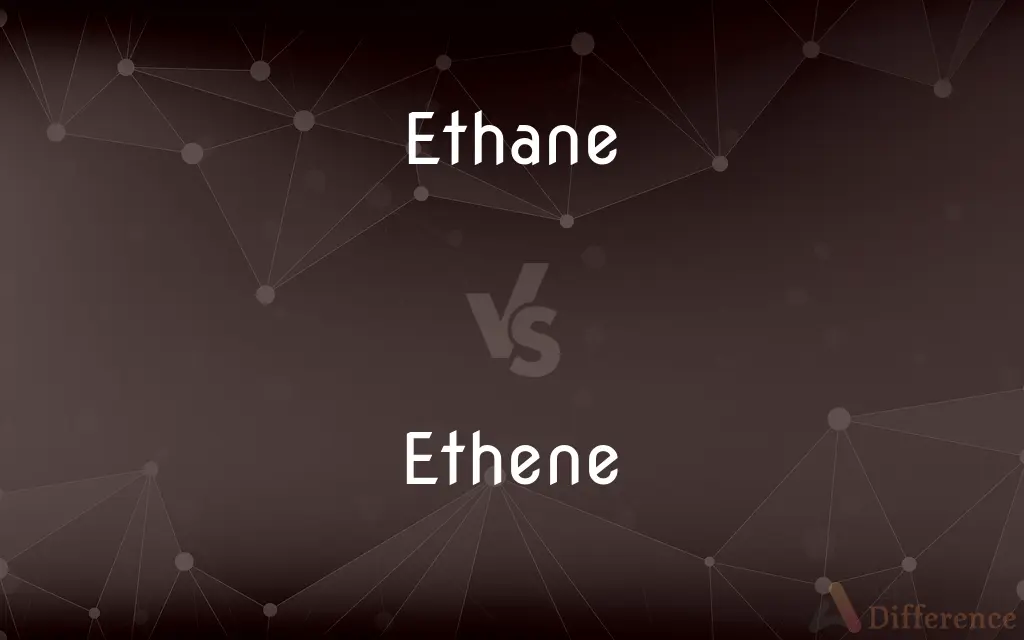Ethane vs. Ethene — What's the Difference?
By Tayyaba Rehman & Maham Liaqat — Updated on April 14, 2024
"Ethane, a saturated hydrocarbon with a single bond between carbon atoms, is less reactive than ethene, an unsaturated hydrocarbon with a double bond, leading to greater chemical activity."

Difference Between Ethane and Ethene
Table of Contents
ADVERTISEMENT
Key Differences
Ethane (C2H6) is an alkane, which means it contains only single bonds between its carbon atoms. This chemical structure makes ethane relatively inert under normal conditions. On the other hand, ethene (C2H4), also known as ethylene, is an alkene and includes a double bond between its two carbon atoms, which increases its reactivity and makes it a key player in the chemical industry.
The presence of a double bond in ethene not only affects its reactivity but also its physical properties. For example, ethene is a gas at room temperature and is much more reactive than ethane due to its ability to participate in addition reactions. In contrast, ethane is also a gas at room temperature but is less reactive, generally requiring more energy to break its chemical bonds.
From an industrial perspective, ethene is critically important in the production of polymers and chemicals, such as polyethylene, one of the most commonly produced plastics. Ethane, while also valuable, is often used as a feedstock in the production of ethene itself, highlighting its role as a precursor rather than a final product.
Environmental and safety considerations also differ significantly between the two gases. Ethene, with its high reactivity, poses greater risks in terms of flammability and toxicity compared to ethane. Ethane, being less reactive, is somewhat safer to handle but still requires careful management due to its flammability and potential as a greenhouse gas.
In terms of applications, ethane's primary use is as a feedstock for ethene production, especially in steam cracking processes where ethane is heated at high temperatures to break down into ethene and other products. Conversely, ethene's applications are broader, directly contributing to the manufacturing of a wide array of chemical products.
ADVERTISEMENT
Comparison Chart
Type of Hydrocarbon
Alkane (single bonds)
Alkene (double bond)
Reactivity
Lower reactivity
Higher reactivity
Industrial Use
Feedstock for ethene
Manufacture of polymers
Safety Risks
Lower (flammable)
Higher (flammable, toxic)
Molecular Structure
CH3-CH3
CH2=CH2
Compare with Definitions
Ethane
A saturated hydrocarbon with a stable single bond between carbons.
Ethane is mainly used as a feedstock in chemical synthesis.
Ethene
Essential for producing many polymers and chemicals.
Ethene undergoes polymerization to form polyethylene.
Ethane
Colorless and odorless gas under normal conditions.
Ethane is part of natural gas and is extracted for various industrial uses.
Ethene
More reactive than ethane, participating in addition reactions.
Ethene can add halogens across its double bond in reaction mechanisms.
Ethane
Found in natural gas and petroleum.
Ethane is separated from natural gas in gas processing plants.
Ethene
An unsaturated hydrocarbon with a reactive double bond.
Ethene easily reacts with other substances due to its double bond.
Ethane
Used primarily to produce ethene by steam cracking.
Ethane is heated to high temperatures to break down into smaller molecules including ethene.
Ethene
Also known as ethylene, a gas used extensively in chemical synthesis.
Ethene is the starting material for making polyethylene plastic.
Ethane
Less reactive alkane, requiring high energy to break bonds.
Ethane combustion involves breaking its stable C-C single bond.
Ethene
Characterized by a higher reactivity that leads to broader industrial applications.
Ethene is used in the synthesis of alcohol, solvents, and other chemicals.
Ethane
Ethane ( or ) is an organic chemical compound with chemical formula C2H6. At standard temperature and pressure, ethane is a colorless, odorless gas.
Ethene
See ethylene.
Ethane
A colourless, odourless, flammable gas which is a constituent of petroleum and natural gas. It is the second member of the alkane series.
Ethene
The organic chemical compound ethylene. The simplest alkene, a colorless gaseous (at room temperature and pressure) hydrocarbon with the chemical formula C2H4
Ethane
A colorless, odorless gaseous alkane, C2H6, that occurs as a constituent of natural gas and is used as a fuel and a refrigerant.
Ethene
(organic chemistry) Any alkene derived from ethylene
Ethane
An aliphatic hydrocarbon, C2H6, gaseous at normal temperatures and pressures, being a constituent of natural gas.
Ethene
Ethylene; olefiant gas.
Ethane
The same compound, subjected to modification by replacing one or more of the hydrogen atoms with other radicals.
Chlorinated ethanes; halogenated ethanes
Ethene
A flammable colorless gaseous alkene; obtained from petroleum and natural gas and used in manufacturing many other chemicals; sometimes used as an anesthetic
Ethane
A gaseous hydrocarbon, C2H6, forming a constituent of ordinary illuminating gas. It is the second member of the paraffin series, and its most important derivatives are common alcohol (ethyl alcohol), acetaldehyde, ether, and acetic acid. Called also dimethyl.
Ethane
A colorless odorless alkane gas used as fuel
Common Curiosities
What are the primary uses of ethane in the industry?
Ethane is primarily used as a feedstock for producing ethene and other chemicals through steam cracking.
How does the presence of a double bond in ethene influence its industrial applications?
The double bond in ethene makes it a key intermediate for synthesizing a wide range of chemicals, particularly polymers like polyethylene.
Are ethane and ethene found in natural sources?
Yes, both ethane and ethene are found in natural gas and petroleum, although ethane is more abundant.
How are ethane and ethene processed for industrial use?
Ethane is processed mainly through steam cracking to produce ethene, whereas ethene is further used to manufacture various industrial chemicals.
What safety measures are necessary when handling ethane and ethene?
Both gases are flammable and must be handled with care to avoid leaks and explosions; ethene also requires precautions due to its toxicity.
How do ethane and ethene contribute to environmental concerns?
Both gases can contribute to air pollution and greenhouse gas emissions, but ethene also poses additional risks due to its higher toxicity.
What are the main chemical differences between ethane and ethene?
Ethane is a saturated hydrocarbon with single bonds only, while ethene is an unsaturated hydrocarbon with at least one double bond.
Can ethene be synthesized from ethane?
Yes, ethene is commonly synthesized from ethane through processes like steam cracking.
Why is ethene more reactive than ethane?
Ethene contains a double bond that is more chemically active than the single bonds in ethane, making it easier to participate in addition reactions.
What role does ethene play in the plastics industry?
Ethene is vital for the plastics industry as it is polymerized to produce polyethylene, one of the most common plastics used globally.
Share Your Discovery

Previous Comparison
City vs. Country
Next Comparison
Insecureness vs. InsecurityAuthor Spotlight
Written by
Tayyaba RehmanTayyaba Rehman is a distinguished writer, currently serving as a primary contributor to askdifference.com. As a researcher in semantics and etymology, Tayyaba's passion for the complexity of languages and their distinctions has found a perfect home on the platform. Tayyaba delves into the intricacies of language, distinguishing between commonly confused words and phrases, thereby providing clarity for readers worldwide.
Co-written by
Maham Liaqat













































